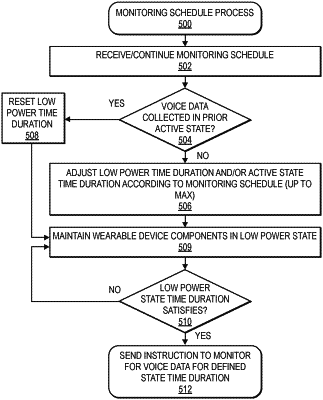| CPC G10L 15/22 (2013.01) [G06F 1/163 (2013.01); G06F 1/189 (2013.01); G06F 1/3287 (2013.01); G10L 25/78 (2013.01)] | 20 Claims |

|
1. A computer-implemented method, comprising:
executing, on a device that includes a battery and a plurality of battery powered components that are powered by the battery, a monitoring schedule that includes a low power state time duration and an active state time duration, wherein the plurality of battery powered components include a voice activity detector;
during a first low power state time duration of the monitoring schedule:
maintaining the plurality of battery powered components in a low power state to preserve a battery charge of the battery;
upon completion of the first low power state time duration:
transitioning the voice activity detector from the low power state to an active state;
generating, at the device and during a first active state time duration of the monitoring schedule, a first audio data; and
determining, at the device and with the voice activity detector during the first active state time duration, that a voice was not detected in the first audio data;
in response to determining that the voice was not detected in the first audio data:
transitioning the voice activity detector to the low power state;
increasing the low power state time duration of the monitoring schedule from the first low power state time duration to a second low power state time duration that is longer than the first low power state time duration; and
maintaining the plurality of battery powered components in the low power state for the second low power state time duration;
upon completion of the second low power state time duration:
transitioning the voice activity detector from the low power state to the active state;
generating, at the device and during a second active state time duration, second audio data; and
determining, at the device and with the voice activity detector during the second active state time duration, that the voice was detected in a second audio data;
in response to determining that the voice was detected:
maintaining the voice activity detector in the active state; and
continuing to collect the second audio data.
|